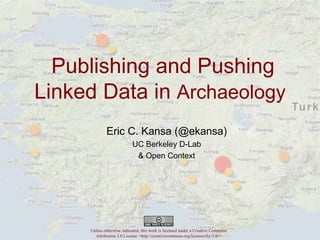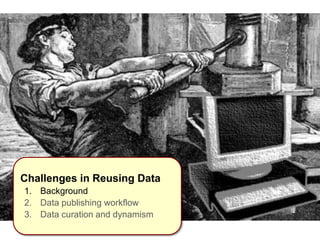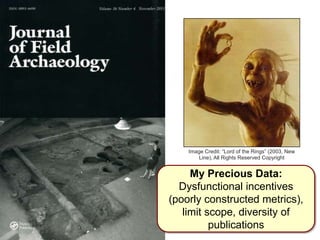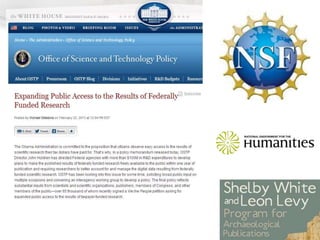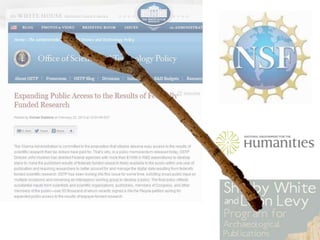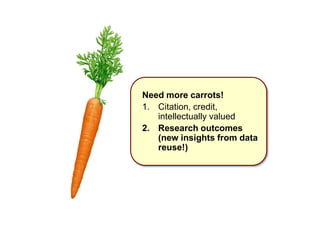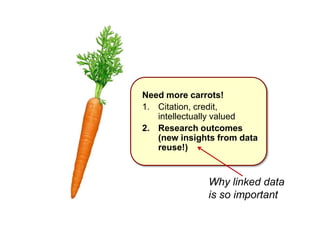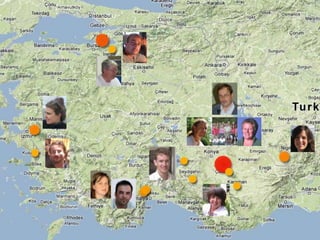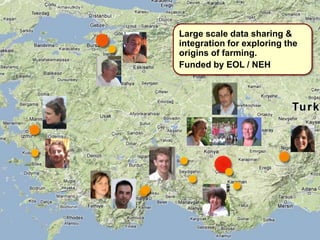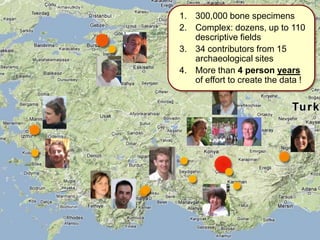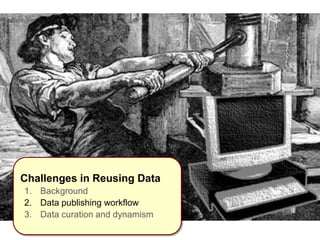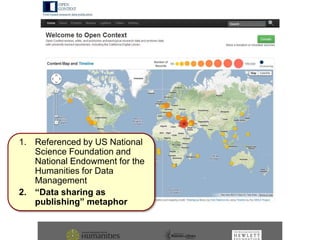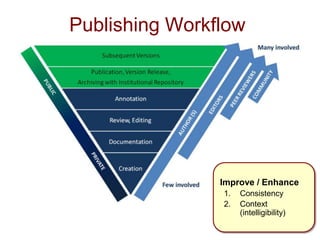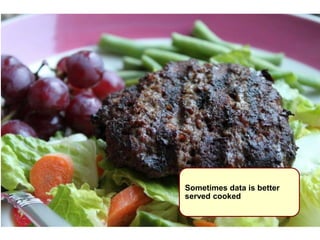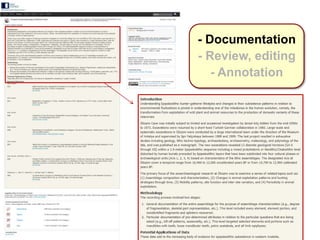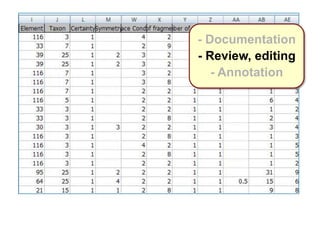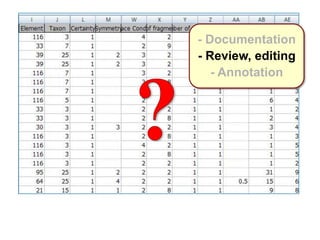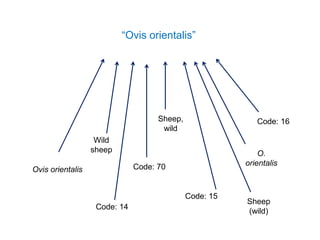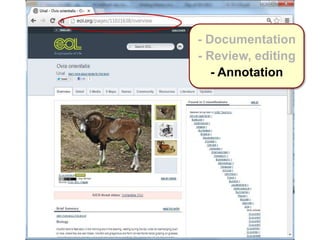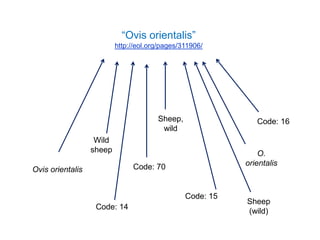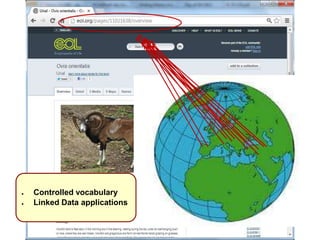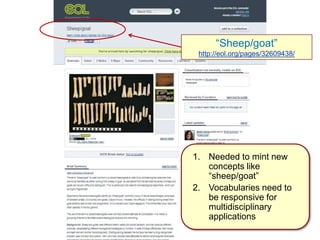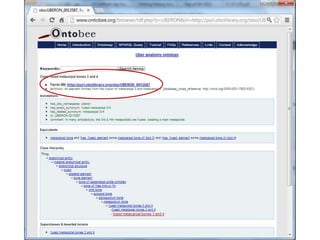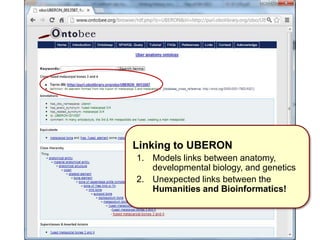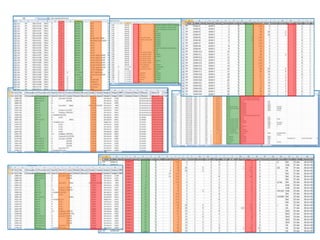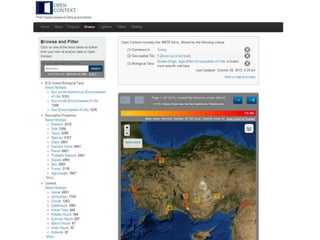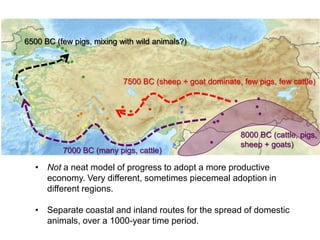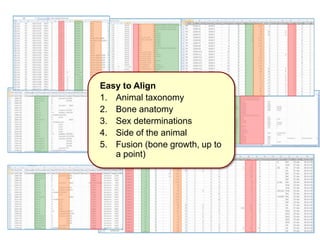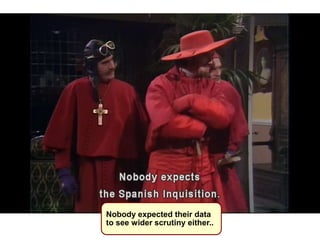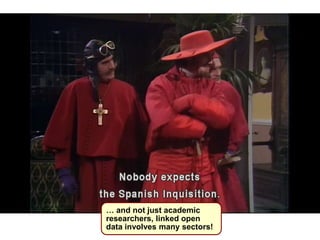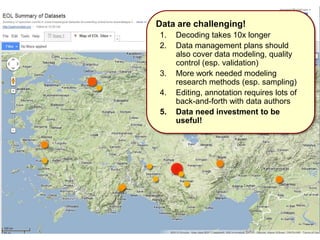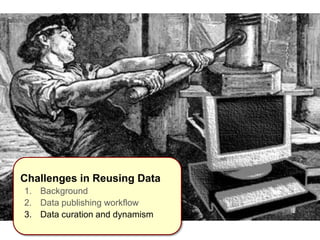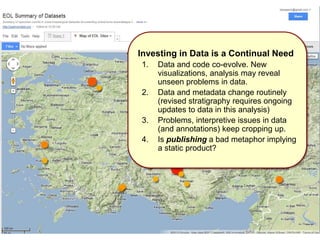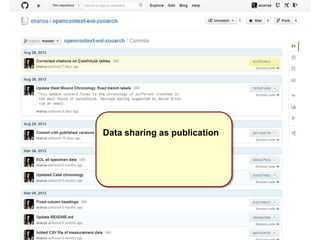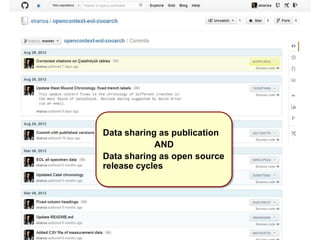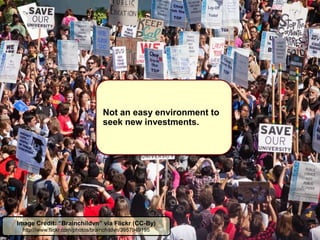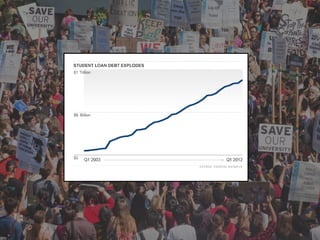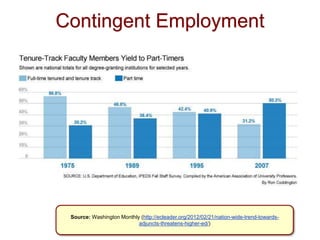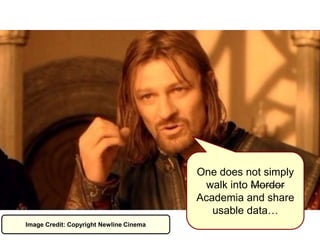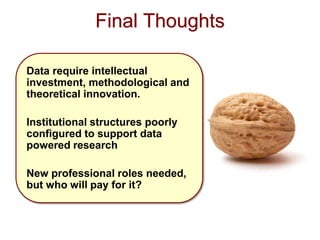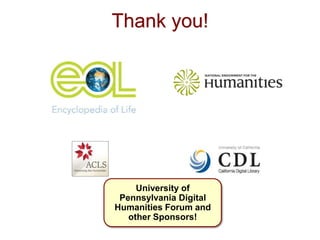Publishing and Pushing Linked Open Data
- 1. Publishing and Pushing Linked Data in Archaeology Unless otherwise indicated, this work is licensed under a Creative Commons Attribution 3.0 License <http://creativecommons.org/licenses/by/3.0/> Eric C. Kansa (@ekansa) UC Berkeley D-Lab & Open Context
- 2. Introduction Challenges in Reusing Data 1. Background 2. Data publishing workflow 3. Data curation and dynamism
- 3. “Gold Standard” of professional contribution
- 4. My Precious Data: Dysfunctional incentives (poorly constructed metrics), limit scope, diversity of publications Image Credit: “Lord of the Rings” (2003, New Line), All Rights Reserved Copyright
- 7. Need more carrots! 1. Citation, credit, intellectually valued 2. Research outcomes (new insights from data reuse!)
- 8. Need more carrots! 1. Citation, credit, intellectually valued 2. Research outcomes (new insights from data reuse!) Why linked data is so important
- 9. EOL Computable Data Challenge (Ben Arbuckle, Sarah W. Kansa, Eric Kansa)
- 11. Large scale data sharing & integration for exploring the origins of farming. Funded by EOL / NEH
- 12. 1. 300,000 bone specimens 2. Complex: dozens, up to 110 descriptive fields 3. 34 contributors from 15 archaeological sites 4. More than 4 person years of effort to create the data !
- 13. Relatively collaborative bunch, Ben Arbuckle cultivated relationships & built trust over years prior to EOL funding.
- 14. Introduction Challenges in Reusing Data 1. Background 2. Data publishing workflow 3. Data curation and dynamism
- 15. 1. Referenced by US National Science Foundation and National Endowment for the Humanities for Data Management 2. “Data sharing as publishing” metaphor
- 16. Raw Data: Idiosyncratic, sometimes highly coded, often inconsistent
- 17. Raw Data Can Be Unappetizing
- 18. Publishing Workflow Improve / Enhance 1. Consistency 2. Context (intelligibility)
- 19. Sometimes data is better served cooked
- 20. - Documentation - Review, editing - Annotation
- 21. - Documentation - Review, editing - Annotation
- 22. - Documentation - Review, editing - Annotation
- 23. - Documentation - Review, editing - Annotation
- 24. - Documentation - Review, editing - Annotation
- 25. “Ovis orientalis” Code: 14 Wild sheep Code: 70 Code: 16 Ovis orientalis Code: 15 Sheep, wild O. orientalis Sheep (wild)
- 26. - Documentation - Review, editing - Annotation
- 27. “Ovis orientalis” http://eol.org/pages/311906/ Code: 14 Wild sheep Code: 70 Code: 16 Ovis orientalis Code: 15 Sheep, wild O. orientalis Sheep (wild)
- 28. â—Ź Controlled vocabulary â—Ź Linked Data applications
- 29. “Sheep/goat” http://eol.org/pages/32609438/ 1. Needed to mint new concepts like “sheep/goat” 2. Vocabularies need to be responsive for multidisciplinary applications
- 32. Linking to UBERON 1. Needed a controlled vocabulary for bone anatomy 2. Better data modeling than common in zooarchaeology, adds quality.
- 33. Linking to UBERON 1. Models links between anatomy, developmental biology, and genetics 2. Unexpected links between the Humanities and Bioinformatics!
- 36. 7000 BC (many pigs, cattle) 7500 BC (sheep + goat dominate, few pigs, few cattle) 6500 BC (few pigs, mixing with wild animals?) 8000 BC (cattle, pigs, sheep + goats) • Not a neat model of progress to adopt a more productive economy. Very different, sometimes piecemeal adoption in different regions. • Separate coastal and inland routes for the spread of domestic animals, over a 1000-year time period.
- 37. Easy to Align 1. Animal taxonomy 2. Bone anatomy 3. Sex determinations 4. Side of the animal 5. Fusion (bone growth, up to a point)
- 38. Hard to Align (poor modeling, recording) 1. Tooth wear (age) 2. Fusion data 3. Measurements Despite common research methods!!
- 39. Professional expectations for data reuse 1. Need better data modeling (than feasible with, cough, Excel) 2. Data validation, normalization 3. Requires training & incentives for researchers to care more about quality of their data!
- 40. Nobody expected their data to see wider scrutiny either..
- 41. … and not just academic researchers, linked open data involves many sectors!
- 42. Digital Index of North American Archaeology (DINAA) 1. State “site files” created to comply with federal preservation laws 2. Main record of human occupation in North America 3. PIs: David G. Anderson and Josh Wells
- 43. DINAA 1. Stable URI for each site file. 2. CC-Zero (public domain) 3. Beginning to link to controlled vocabularies
- 44. Data are challenging! 1. Decoding takes 10x longer 2. Data management plans should also cover data modeling, quality control (esp. validation) 3. More work needed modeling research methods (esp. sampling) 4. Editing, annotation requires lots of back-and-forth with data authors 5. Data need investment to be useful!
- 45. Introduction Challenges in Reusing Data 1. Background 2. Data publishing workflow 3. Data curation and dynamism
- 46. Investing in Data is a Continual Need 1. Data and code co-evolve. New visualizations, analysis may reveal unseen problems in data. 2. Data and metadata change routinely (revised stratigraphy requires ongoing updates to data in this analysis) 3. Problems, interpretive issues in data (and annotations) keep cropping up. 4. Is publishing a bad metaphor implying a static product?
- 48. Data sharing as publication Data sharing as open source release cycles?
- 49. Data sharing as publication Data sharing as open source release cycles?
- 50. Data sharing as publication AND Data sharing as open source release cycles
- 51. Data are challenging! 1. Decoding takes 10x longer 2. Data management plans should also cover data modeling, quality control (esp. validation) 3. More work needed modeling research methods (esp. sampling) 4. Editing, annotation requires lots of back-and-forth with data authors 5. Data need investment to be useful!
- 52. Image Credit: “Brainchildvn” via Flickr (CC-By) http://www.flickr.com/photos/brainchildvn/3957949195
- 53. Image Credit: “Brainchildvn” via Flickr (CC-By) http://www.flickr.com/photos/brainchildvn/3957949195 Not an easy environment to seek new investments.
- 55. Contingent Employment Source: Washington Monthly (http://ecleader.org/2012/02/21/nation-wide-trend-towards- adjuncts-threatens-higher-ed/)
- 56. Bethany Nowviskie (University of Virginia) Shifts in Career Paths and Professions (#alt-academy), different publishing incentives, emerging as data assume a greater emphasis
- 57. Bethany Nowviskie (University of Virginia) Alt-Acs (contingent, low status) not a good answer, but reflect wider need for institutional reform.
- 58. One does not simply walk into Mordor Academia and share usable data… Image Credit: Copyright Newline Cinema
- 59. Final Thoughts Data require intellectual investment, methodological and theoretical innovation. Institutional structures poorly configured to support data powered research New professional roles needed, but who will pay for it?
- 60. Thank you! University of Pennsylvania Digital Humanities Forum and other Sponsors!
Editor's Notes
- #10: The removal of objects is now forbidden in most countries and many sites in the US. As a result data collection methods have changed from description of a physical object accessible in the US to a full surrogate for an object that might be re-buried in the ground. Data collection has increased as the collection of objects has decreased.Still individual systems of data collection (see examples on the right) have emerged which have.Developed over timeAre Handed down from mentors Contain some technological adoption, particularly the adoption of Excel spreadsheets over relational databasesIn all of our interviews there was no reference to existing guides, such as the UK: Archaeological Data Service or Netherlands: DANS on archaeological documentation.
- #18: We used archaeology as a case study. During our 22 semi-structured interviews archaeologists were asked about their1. background and research interests2. data reuse experiences:Actual experience using the critical incident (i.e. the last time they reused someone else’s data for their research)Aspirational - for those who had not reused someone else’s data we asked what they would need or want in order to do so3. views on digital data repositories4. data sharing practices
- #19: The removal of objects is now forbidden in most countries and many sites in the US. As a result data collection methods have changed from description of a physical object accessible in the US to a full surrogate for an object that might be re-buried in the ground. Data collection has increased as the collection of objects has decreased.Still individual systems of data collection (see examples on the right) have emerged which have.Developed over timeAre Handed down from mentors Contain some technological adoption, particularly the adoption of Excel spreadsheets over relational databasesIn all of our interviews there was no reference to existing guides, such as the UK: Archaeological Data Service or Netherlands: DANS on archaeological documentation.
- #20: The removal of objects is now forbidden in most countries and many sites in the US. As a result data collection methods have changed from description of a physical object accessible in the US to a full surrogate for an object that might be re-buried in the ground. Data collection has increased as the collection of objects has decreased.Still individual systems of data collection (see examples on the right) have emerged which have.Developed over timeAre Handed down from mentors Contain some technological adoption, particularly the adoption of Excel spreadsheets over relational databasesIn all of our interviews there was no reference to existing guides, such as the UK: Archaeological Data Service or Netherlands: DANS on archaeological documentation.
- #22: The removal of objects is now forbidden in most countries and many sites in the US. As a result data collection methods have changed from description of a physical object accessible in the US to a full surrogate for an object that might be re-buried in the ground. Data collection has increased as the collection of objects has decreased.Still individual systems of data collection (see examples on the right) have emerged which have.Developed over timeAre Handed down from mentors Contain some technological adoption, particularly the adoption of Excel spreadsheets over relational databasesIn all of our interviews there was no reference to existing guides, such as the UK: Archaeological Data Service or Netherlands: DANS on archaeological documentation.
- #23: The removal of objects is now forbidden in most countries and many sites in the US. As a result data collection methods have changed from description of a physical object accessible in the US to a full surrogate for an object that might be re-buried in the ground. Data collection has increased as the collection of objects has decreased.Still individual systems of data collection (see examples on the right) have emerged which have.Developed over timeAre Handed down from mentors Contain some technological adoption, particularly the adoption of Excel spreadsheets over relational databasesIn all of our interviews there was no reference to existing guides, such as the UK: Archaeological Data Service or Netherlands: DANS on archaeological documentation.
- #24: The removal of objects is now forbidden in most countries and many sites in the US. As a result data collection methods have changed from description of a physical object accessible in the US to a full surrogate for an object that might be re-buried in the ground. Data collection has increased as the collection of objects has decreased.Still individual systems of data collection (see examples on the right) have emerged which have.Developed over timeAre Handed down from mentors Contain some technological adoption, particularly the adoption of Excel spreadsheets over relational databasesIn all of our interviews there was no reference to existing guides, such as the UK: Archaeological Data Service or Netherlands: DANS on archaeological documentation.
- #25: The removal of objects is now forbidden in most countries and many sites in the US. As a result data collection methods have changed from description of a physical object accessible in the US to a full surrogate for an object that might be re-buried in the ground. Data collection has increased as the collection of objects has decreased.Still individual systems of data collection (see examples on the right) have emerged which have.Developed over timeAre Handed down from mentors Contain some technological adoption, particularly the adoption of Excel spreadsheets over relational databasesIn all of our interviews there was no reference to existing guides, such as the UK: Archaeological Data Service or Netherlands: DANS on archaeological documentation.
- #45: The removal of objects is now forbidden in most countries and many sites in the US. As a result data collection methods have changed from description of a physical object accessible in the US to a full surrogate for an object that might be re-buried in the ground. Data collection has increased as the collection of objects has decreased.Still individual systems of data collection (see examples on the right) have emerged which have.Developed over timeAre Handed down from mentors Contain some technological adoption, particularly the adoption of Excel spreadsheets over relational databasesIn all of our interviews there was no reference to existing guides, such as the UK: Archaeological Data Service or Netherlands: DANS on archaeological documentation.
- #47: The removal of objects is now forbidden in most countries and many sites in the US. As a result data collection methods have changed from description of a physical object accessible in the US to a full surrogate for an object that might be re-buried in the ground. Data collection has increased as the collection of objects has decreased.Still individual systems of data collection (see examples on the right) have emerged which have.Developed over timeAre Handed down from mentors Contain some technological adoption, particularly the adoption of Excel spreadsheets over relational databasesIn all of our interviews there was no reference to existing guides, such as the UK: Archaeological Data Service or Netherlands: DANS on archaeological documentation.
- #52: The removal of objects is now forbidden in most countries and many sites in the US. As a result data collection methods have changed from description of a physical object accessible in the US to a full surrogate for an object that might be re-buried in the ground. Data collection has increased as the collection of objects has decreased.Still individual systems of data collection (see examples on the right) have emerged which have.Developed over timeAre Handed down from mentors Contain some technological adoption, particularly the adoption of Excel spreadsheets over relational databasesIn all of our interviews there was no reference to existing guides, such as the UK: Archaeological Data Service or Netherlands: DANS on archaeological documentation.

